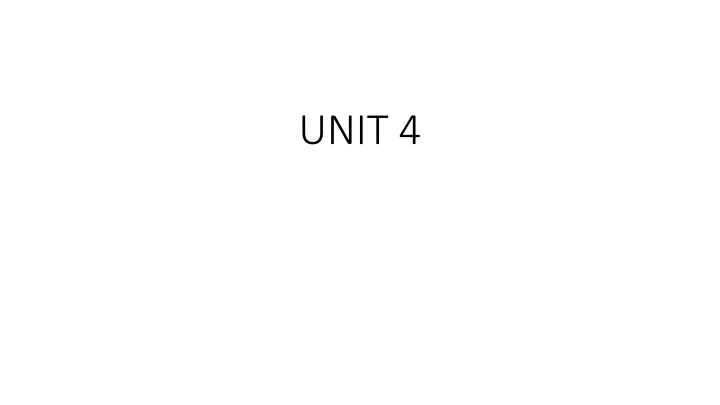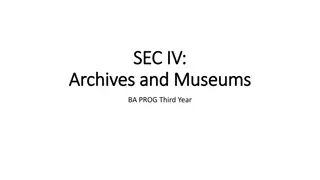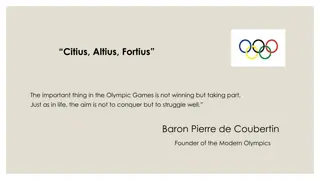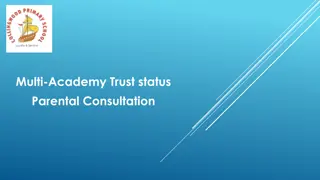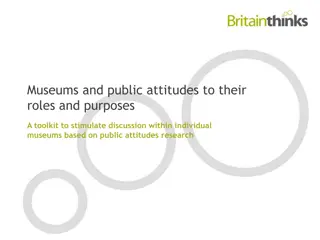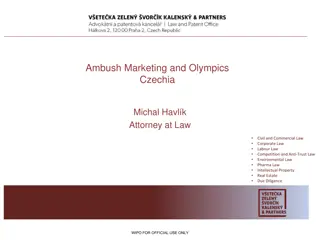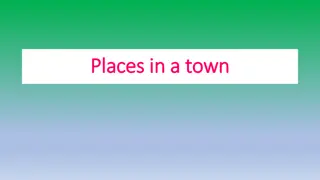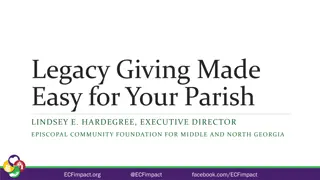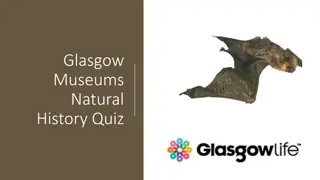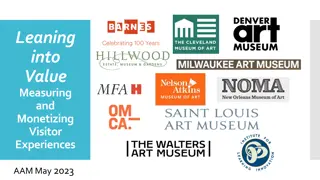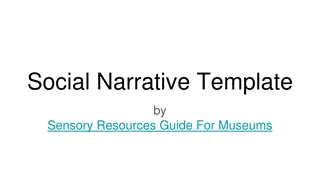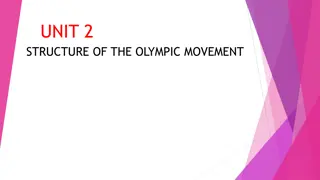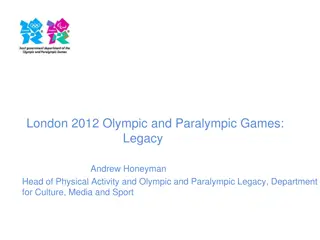The Olympic Legacy: Museums and Academy
Founded in Lausanne, the Olympic Museum is a treasure trove of over 10,000 artifacts showcasing the history and values of the Olympic movement. With a mission to promote sport values, the Olympic Museums Network collaborates on exhibitions, educational programs, and more. The International Olympic Academy in ancient Olympia serves as a cultural hub, preserving the Olympic spirit and fostering global cooperation through academic research and programs.
Download Presentation

Please find below an Image/Link to download the presentation.
The content on the website is provided AS IS for your information and personal use only. It may not be sold, licensed, or shared on other websites without obtaining consent from the author.If you encounter any issues during the download, it is possible that the publisher has removed the file from their server.
You are allowed to download the files provided on this website for personal or commercial use, subject to the condition that they are used lawfully. All files are the property of their respective owners.
The content on the website is provided AS IS for your information and personal use only. It may not be sold, licensed, or shared on other websites without obtaining consent from the author.
E N D
Presentation Transcript
OLYMPIC MUSEUM Founded on 7 September 2006 in Lausanne under the leadership of IOC Presidents Rogge and Samaranch. The Olympic Museum situated in Lausanne, Switzerland which is relating to sport and the Olympic movement. With more than 10,000 artefacts(an object which is made by the person). The museum is the largest archive of Olympic Games in the world and one of Lausanne's prime tourist site draws attracting more than 250,000 visitors each year. The idea is not to take the place of existing associations such as the ICOM (International Council of Museums), but rather to make a group of institutions with the same subject matter, the ultimate goal being to grow together and get united where possible in order to be stronger and more efficient, to create a unique platform for the global Olympic Movement. big projects for new Olympic Museums and the potential creation of a global platform to reach not only physical visitors but also virtual visitors. The Olympic Museum and the Olympic Park (sculpture garden between the museum and Lake L man) are located at Ouchy, south of Lausanne. The headquarters of the International Olympic Committee (IOC) are located at Vidy, to the west of Ouchy.
Mission The Olympic Museums Network s main objective is to increase the promotion of the values of Sport and the Olympism by: 1.Sharing information and best practices 2.Encouraging cooperation on common issues encountered by the members 3.Working on common projects, in particular in relation to exhibitions, educational programmes, events, collections management, communication and commercial development 4.Finding ways to work in common in order to improve the efficiency and achieve economies of scales to the benefit of the members of the network
The International Olympic Academy Located in ancient Olympia and supported by the IOC, the International Olympic Academy is devoted to create an international cultural centre in Olympia, to preserve and spread the Olympic Spirit, study and implement the educational and social principles of Olympism and consolidate the scientific basis of the Olympic Ideal. The principles laid down by the ancient Greeks and the revivers of the Olympic Movement, through Baron de Coubertin's initiative. The mission of the IOA is: 1. To function as an International Academic Centre for Olympic Studies, Education and Research. 2. To act as an International Forum for free expression and exchange of ideas among the Olympic Family, intellectuals, scientists, athletes, sports administrators, educators, artists and the youth of the world. 3. To bring together people from all over the world, in a spirit of friendship and cooperation. 4. In promoting the Olympic Ideals in their respective countries. 5. To cooperate with and assist the National Olympic Academies and any other institutions devoted to Olympic Education. 6. To further explore and enhance the contribution of Olympism to humanity. In 1961, the IOA inaugurated its first program, the International Session for Young Participants, that was the only IOC Session by that time. It was hosted under tents. In 1993 the IOA started the "International Session for Educators and Officials of Higher Institutes of Physical Education" with the "International Seminar on Olympic Studies for Postgraduate Students" In 2007, the "International Session for Olympic Medalists" was started
History of Olympic Solidarity History of Olympic Solidarity 1960 The IOC decided to set up its own assistance programme for the NOCs, with a particular focus on supporting a certain number of NOCs that had been created when their countries gained independence and, through them, contribute to the development of sport and the Olympic ideals. 1971 The Committee for Olympic Solidarity was created. 1973 Efforts continued with the aim of improving assistance to those NOCs in greatest need. A lack of financial resources made any progress virtually impossible. In the 1960s and 1970s, more than 50 new NOCs were created in countries that had very few resources to develop sport in their territories. 1979 The IOC granted 20 per cent of revenues from television rights 1984 Olympic Solidarity was moved to an income management structure that met IOC criteria, rather than providing a general subsidy, a move made possible by the increase in television rights revenues. 2001 The current structure of Olympic Solidarity s programmes was established by IOC President Jacques Rogge. 2019 Robin E. Mitchell, IOC member, became Chair of the Olympic Solidarity Commission.
AIM AIM Today, Olympic Solidarity s mission is to provide assistance to NOCs for athlete development programmes, in particular those with the greatest need, so that NOCs can fulfill their responsibilities to the Olympic Movement. This assistance takes the form of multi-phase programmes prioritising athletes, but also training of coaches and sports administrators, and promoting the Olympic values. Its mission was to serve the interests and meet the needs of the NOCs. Olympic Solidarity helps the NOCs to develop their own structures through relevant and targeted programmes, which enables them not only to consolidate their place and role within the Olympic Movement and their own national structures, but also to increase their autonomy and independence. Olympic Solidarity function autonomously and complement one another. They cover the objectives of the NOCs, which are mainly to improve their functioning and organizational ability, to create or develop efficient structures, to organise training courses at various levels, and to benefit from the technical and financial resources available, which in turn will benefit their athletes.
Olympic Solidarity The three sections World Programmes, Continental Programmes and IOC Subsidies for NOCs Participation in Olympic Games and Youth Olympic Games
World Programmes World Programmes World Programmes provide technical, financial and administrative assistance to the NOCs for the organisation of specific sports development activities. They are essential for enabling the NOCs to fulfill their mission, as defined in the Olympic Charter. The programmes are divided into three development areas and five programme clusters. The Olympic Solidarity international office in Lausanne manages the World Programmes. If the situation requires, it may call upon the continental offices within the Continental Associations to coordinate activities within their continents, according to their specific needs. Olympic Solidarity works closely with the IFs, the IOC commissions and various other partners within the Olympic Movement to develop and provide World Programmes of a high quality.
Continental Programmes and ANOC Continental Programmes and ANOC Throughout the Olympic Solidarity 2021-2024 Plan, the five Continental Associations of NOCs can offer specific Continental Programmes to their constituent NOCs. Continental Programmes offer the NOCs access to technical, financial and administrative assistance which addresses the specific needs and priorities of the NOCs in that continent. Taking into consideration the global Olympic Solidarity priorities and targets for the 2021-2024 period When drawing up and developing their Continental Programmes and budgets for 2021-2024, the Continental Associations should cover several minimum basic and common requirements, including allocating annual direct subsidies of a minimum of USD 125,000 to each NOC for the development of their own NOC programme of national activities.
IOC Subsidies for NOCs IOC Subsidies for NOCs Participati Games and Youth Olympic Games Games and Youth Olympic Games articipation in Olympic n in Olympic The IOC Subsidies for NOCs Participation in Olympic Games and Youth Olympic Games provided by Olympic Solidarity aim to assist NOCs in covering part of the costs linked to their participation in the Olympic Games and the Youth Olympic Games. The World Programmes are split into three development areas and five programme clusters covering specific sports development activities. The Continental Programmes meet the NOCs specific needs, taking into account the priorities of each continent. IOC Subsidies for NOCs Participation in Olympic Games and Youth Olympic Games support the NOCs at three stages: before, during and after the Games.
The Paralympic Games or Paralympics, also known as the Games of the Paralympiad, is a periodic series of international multisport events involving athletes with a range of physical disabilities. There are Winter and Summer Paralympic Games, which was since the 1988 Summer Olympics in Seoul, South Korea, are held almost immediately following the respective Olympic Games. All Paralympic Games are governed by the International Paralympic Committee (IPC).
The first organized athletic event for disabled athletes that coincided with the Olympic Games took place on the day of the opening of the 1948 Summer Olympics in London. Dr Ludwig Guttmann of Stoke Mandeville Hospital, hosted a sports competition for British World War II veterans in 1948 to one of the largest international sporting events by the early 21st century. The present formal explanation for the name is that it derives from the Greek preposition par ('beside' or 'alongside') and thus refers to a competition held in parallel with the Olympic Games.The Summer Games of 1988 held in Seoul was the first time the term Paralympic came into official use. The first games were called the 1948 International Wheelchair Games Paralympians strive for equal treatment with non-disabled Olympic athletes, but there is a large funding gap between Olympic and Paralympic athletes. The IOC-recognized Special Olympics World Games include athletes with intellectual disabilities Given the wide variety of disabilities that Para athletes have, there are several categories in which the athletes compete. The allowable disabilities are broken down into ten eligible impairment types. These are impaired muscle power, impaired passive range of movement, limb deficiency, leg length difference, short stature, hypertonia, ataxia, athetosis, vision impairment and intellectual impairment. These categories are further broken down into various classifications.
It comprises 176 National Paralympic Committees (NPC) and four disability-specific international sports federations. The president of the IPC is Andrew Parsons. The IPC's international headquarters are in Bonn, Germany. The IPC is responsible for organizing the Summer and Winter Paralympic Games. It also serves as the International Federation for nine sports (Paralympic athletics, Paralympic swimming, Paralympic archery, Paralympic powerlifting, Para-alpine skiing, Paralympic biathlon, Paralympic cross-country skiing, ice sledge hockey and Wheelchair DanceSport).
"Spirit in Motion" is the current motto for the Paralympic movement. The current Paralympic flag is used since 2020 and contains three colours, red, blue, and green, which are the colours most widely represented in the flags of nations. The colours are each in the shape of an Agito (which is Latin for 'I move/I shake/I stir'), which is the name given to an asymmetrical crescent specially designed for the Paralympic movement. The three Agitos circle a central point. The motto and symbol of the IPC were changed in 2003 to their current versions.
Opening Various elements frame the opening ceremony of the Paralympic Games. Most of these rituals were established at the 1920 Summer Olympics in Antwerp and were shared with the Olympic Games. The ceremony typically starts with the hoisting of the host country's flag and a performance of its national anthem. Unlike the Olympic Games, immediately after the national anthem the athletes parade into the stadium grouped by nation. Since the 1960 Summer Paralympics, the nations enter the stadium alphabetically according to the host country's or region official language, though with the host country's athletes being the last to enter. The host nation presents artistic displays of music, singing, dance, and theatre representative of its culture. Speeches are given, formally opening the games. Finally, the Paralympic flame is brought into the stadium and passed on until it reaches the final torch carrier often a Paralympic athlete from the host nation who lights the Paralympic flame in the stadium's cauldron
Closing The closing ceremony of the Paralympic Games takes place after all sporting events have concluded. Flag-bearers from each participating country enter, followed by the athletes who enter together, without any national distinction. The Paralympic flag is taken down. Since the 1988 Winter Paralympics, with some exceptions, the national flag of the country hosting the next Summer or Winter Paralympic Games is hoisted while the corresponding national anthem is played. The games are officially closed, and the Paralympic flame is extinguished.
